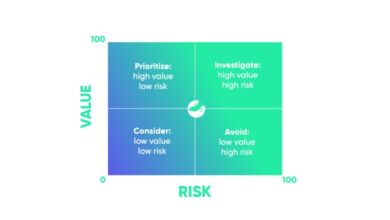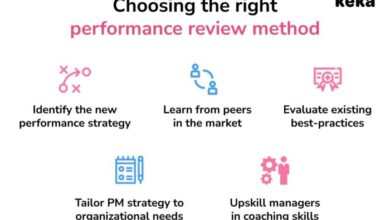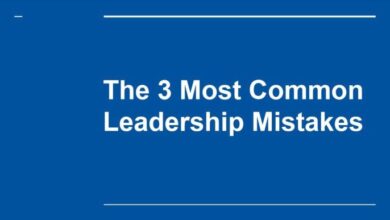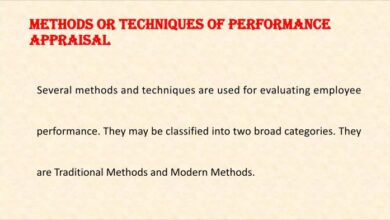
How to drive performance with OKRs is a critical skill for any organization aiming for success. This guide delves into the strategies and techniques for effectively using Objectives and Key Results (OKRs) to boost team performance and achieve ambitious business goals. We’ll explore everything from defining clear OKRs to tracking progress and adapting to changing circumstances, ensuring your team stays motivated and on track.
This comprehensive guide breaks down the process of defining, aligning, and using OKRs to drive measurable improvements in performance. From setting ambitious but achievable targets to fostering a culture of continuous improvement, we’ll cover every step of the journey. Learn how to turn your goals into concrete results using OKRs as your compass.
Defining OKRs for Performance
OKRs, or Objectives and Key Results, are a powerful framework for setting ambitious goals and measuring progress toward them. They provide a structured approach to defining what you want to achieve and how you will measure success, fostering a shared understanding and driving accountability within teams and organizations. This structured method helps individuals and teams stay focused on priorities and track progress effectively.Well-defined OKRs are crucial for driving performance.
They provide a clear roadmap, ensuring everyone understands the targets and how their individual contributions align with overall strategic goals. By focusing on specific, measurable, and time-bound objectives, OKRs empower teams to prioritize tasks, track progress, and ultimately achieve desired outcomes. This clarity and focus are essential for maximizing performance and achieving meaningful results.
Objective and Key Result Definition
Objectives are broad statements of what you aim to accomplish. They articulate the desired outcome or area of focus. Key Results (KRs) are specific, measurable metrics that demonstrate progress toward achieving the objective. Effective KRs are quantifiable, time-bound, and verifiable. They provide concrete evidence of progress and success.
For example, an objective might be “Increase brand awareness,” while a KR might be “Increase social media followers by 20% in Q3.”
Key Elements of a Strong OKR
A robust OKR encompasses several key elements that contribute to its effectiveness. These elements are crucial for achieving the desired results.
- Specificity: Objectives and Key Results should be clearly defined and unambiguous. Vague or overly broad statements hinder progress and understanding. For instance, instead of “Improve customer satisfaction,” a specific objective could be “Increase customer satisfaction scores by 15% by the end of Q4.”
- Measurability: Key Results should be quantifiable, allowing for easy tracking and assessment of progress. They should use metrics that are readily measurable and comparable.
- Achievability: While ambitious, OKRs should be realistic and attainable within the given timeframe. Unrealistic goals can lead to demotivation and a sense of futility.
- Relevance: OKRs should align with overall strategic goals and priorities. They should contribute directly to the organization’s mission and vision. If an objective is not relevant to the company’s strategy, it will not drive the desired results.
- Time-bound: OKRs should have a defined timeframe for completion. This provides a sense of urgency and focus, motivating teams to stay on track.
OKR Template
A well-structured template streamlines the process of defining and tracking OKRs. This template helps to maintain clarity and consistency.
Objective: [Broad statement of what you want to achieve] Key Result 1: [Specific, measurable, achievable, relevant, and time-bound metric 1] (e.g., Increase website traffic by 15% by Q3) Key Result 2: [Specific, measurable, achievable, relevant, and time-bound metric 2] (e.g., Improve customer satisfaction scores by 10% by Q4) Key Result 3: [Specific, measurable, achievable, relevant, and time-bound metric 3] (e.g., Launch new product feature A by Q4)
Different OKR Types
Different types of OKRs can be used to cater to various needs and situations.
The appropriate type depends on the specific goal and the context in which it is being used.
| OKR Type | Description | Example |
|---|---|---|
| Strategic OKRs | Set the overall direction for the organization. | Increase market share by 10% within the next 3 years. |
| Team OKRs | Guide individual team efforts to contribute to broader objectives. | Increase sales conversions by 15% in Q3. |
| Project OKRs | Focus on specific projects or initiatives. | Develop and launch new mobile app feature by Q4. |
| Individual OKRs | Personal goals aligned with team and organizational objectives. | Complete 10 new client onboarding processes by end of Q3. |
Aligning OKRs with Business Strategy
OKRs are powerful tools for driving performance, but their effectiveness hinges on their alignment with broader business objectives. Simply setting ambitious goals within a team isn’t enough; they need to contribute to the overall strategic vision of the organization. This alignment ensures that individual and team efforts are focused on the company’s key priorities, maximizing impact and resource utilization.
Aligning OKRs with business strategy is a crucial step in ensuring that all efforts are coordinated towards achieving the same strategic goals. It’s not just about setting individual targets, but about creating a unified system of goals that cascades down from the top level to the individual contributor level. This cascading effect ensures that everyone understands their role in the bigger picture, ultimately driving the business towards success.
Cascading OKRs Down the Organization
The cascading of OKRs is a structured process that ensures alignment from top to bottom. It requires a clear understanding of the overarching business strategy and the ability to break down these strategic objectives into more manageable, departmental, and individual goals.
- Starting with the Executive Level: The CEO and senior leadership define the overarching company-wide OKRs that represent the strategic priorities for the upcoming period. These are broad, high-level objectives focused on the core business drivers.
- Departmental Alignment: Each department then translates these high-level OKRs into departmental OKRs that directly support the overarching strategic goals. These departmental OKRs are more specific and address how the department will contribute to achieving the overall business objectives. For example, if the overarching goal is to increase market share, a sales department’s OKR might be to acquire 15% more customers in a specific geographic region.
- Team and Individual OKRs: Teams and individual contributors then define their own OKRs that directly support the departmental OKRs. These OKRs should be specific, measurable, achievable, relevant, and time-bound (SMART). This cascading effect ensures that everyone understands how their work contributes to the broader business strategy. For example, a team might aim to close 10 deals per month to support the departmental goal of acquiring new customers.
The Role of Leadership in Championing OKRs
Leaders play a pivotal role in the successful implementation of OKRs. They need to be active champions, driving engagement and ensuring alignment throughout the organization. This goes beyond simply assigning tasks; it involves creating a culture of accountability and collaboration.
- Leading by Example: Leaders must demonstrate commitment to OKRs by actively participating in the goal-setting process and consistently communicating the importance of alignment.
- Providing Resources and Support: Leaders should ensure that teams have the necessary resources, training, and support to achieve their OKRs. This might include providing access to relevant tools, technology, and mentorship.
- Regular Check-ins and Feedback: Regular check-ins, both at the team and individual level, are crucial for monitoring progress, addressing roadblocks, and providing constructive feedback. This promotes a culture of transparency and accountability.
Importance of Clear Communication in OKR Alignment
Effective communication is essential for ensuring that everyone understands their role in achieving the overall business objectives. Without clear communication, teams may struggle to understand the broader context of their work, leading to misalignment and wasted effort.
- Transparent Communication Channels: Establish clear communication channels for sharing information about OKRs, progress updates, and any changes to the strategic direction. This might include regular team meetings, newsletters, or dedicated intranet pages.
- Regular Updates and Reporting: Implement regular updates and reporting mechanisms to track progress against OKRs. This provides transparency into the overall performance and allows for adjustments as needed. Regular reporting helps teams stay focused and motivated.
- Open Dialogue and Feedback Mechanisms: Create an environment where team members feel comfortable asking questions, providing feedback, and raising concerns. Open dialogue and feedback mechanisms foster a culture of collaboration and alignment.
Setting Ambitious but Achievable OKRs
OKRs, or Objectives and Key Results, are powerful tools for driving performance and achieving ambitious goals. However, simply setting lofty objectives isn’t enough. The key lies in crafting OKRs that are not only challenging but also realistically achievable. This requires careful planning, a deep understanding of your team’s capabilities, and a pragmatic approach to resource allocation. This section dives into the strategies for setting ambitious yet attainable OKRs.
Effective OKRs require a delicate balance between pushing boundaries and ensuring feasibility. By understanding the factors influencing achievability and implementing practical strategies, teams can leverage OKRs to drive significant improvements and achieve outstanding results.
Strategies for Setting Challenging but Attainable Objectives and Key Results
Setting ambitious but attainable OKRs involves a thoughtful process. It’s crucial to understand the team’s capabilities, available resources, and potential obstacles. A crucial step is ensuring alignment with the overarching business strategy. This proactive approach helps ensure that the efforts contribute meaningfully to the overall organizational goals.
- Clearly Define Objectives: Objectives should articulate the desired outcomes, ideally in one concise statement. Vague objectives lead to vague Key Results. A well-defined objective provides a clear north star for the team’s efforts.
- Break Down Complex Objectives into Measurable Key Results: Complex objectives need to be deconstructed into specific, measurable, achievable, relevant, and time-bound (SMART) Key Results. This process ensures that progress is tracked and that the objective is attainable.
- Consider Resource Constraints: Realistic OKRs consider the available resources, including time, budget, and personnel. Underestimating resource needs can lead to frustration and missed targets. A thorough assessment of available resources ensures that the OKRs are attainable within the constraints.
- Establish Realistic Timelines: Timelines for achieving Key Results should be ambitious yet attainable. Overly ambitious deadlines can lead to burnout and poor quality output. Consider historical data and project timelines to ensure a realistic yet challenging timeline.
Examples of Effective OKRs
Effective OKRs are not just theoretical constructs; they drive real-world improvements. A well-crafted set of OKRs can propel a team to significantly enhanced performance. Examples are essential to illustrate the practical application of the concept.
- Objective: Increase customer satisfaction scores by 15%.
- Key Result 1: Implement a customer feedback system within Q3.
- Key Result 2: Reduce customer support tickets by 10%.
- Key Result 3: Achieve a 4.5-star average customer rating on review platforms by Q4.
- Objective: Increase website traffic by 20% in the next quarter.
- Key Result 1: Increase organic search traffic by 15% through optimized content.
- Key Result 2: Launch a social media campaign that generates 5,000 new website visitors.
- Key Result 3: Increase website conversions by 10%.
Comparison of SMART Goals and OKRs
SMART goals and OKRs share similarities but differ significantly in their approach.
| Characteristic | SMART Goals | OKRs |
|---|---|---|
| Focus | Individual or departmental goals | Organizational or team goals |
| Specificity | High | Moderate |
| Measurability | Measurable metrics | Key results with measurable metrics |
| Ambition | Usually less ambitious | Ambitious |
| Timeframe | Typically shorter | Usually longer |
SMART goals are effective for individual tasks or smaller projects. OKRs, however, are designed to drive strategic initiatives and align the entire organization toward a common goal.
Tracking Progress and Measuring Results

OKRs are only as effective as your ability to track and measure their progress. Without a robust system for monitoring performance, you risk losing sight of your objectives and potentially wasting valuable time and resources. This crucial step ensures that your team remains focused and aligned, enabling you to adapt strategies as needed.
Effective tracking allows you to identify roadblocks early, celebrate milestones, and make necessary course corrections. By diligently monitoring progress and analyzing results, you can maximize the impact of your OKRs and ultimately achieve your strategic goals.
Process for Tracking Progress toward OKRs
A systematic approach to tracking OKRs is vital for maintaining momentum and ensuring accountability. Start by clearly defining metrics for each key result. These metrics should be quantifiable and measurable, allowing you to objectively assess progress. Establish regular reporting intervals, such as weekly or bi-weekly check-ins, to monitor performance. Document all progress updates and any encountered challenges, maintaining a centralized record for easy reference.
This detailed record will facilitate effective problem-solving and informed decision-making. Regular communication among team members and stakeholders is essential for transparent progress updates.
Driving performance with OKRs hinges on open communication, and that includes understanding how to give and receive feedback effectively. Knowing the rules of upward feedback is crucial. By following these guidelines, you can foster a more transparent and productive work environment, ultimately leading to better results across the board. This, in turn, helps you achieve those ambitious OKRs you’ve set.
Dashboard Design for Monitoring OKR Performance
A well-designed dashboard is crucial for visualizing OKR progress at a glance. The dashboard should present a clear overview of key metrics, highlighting both successes and areas needing attention. A color-coded system, with green for on-track progress, yellow for areas requiring attention, and red for significant issues, can help quickly identify trends. Consider incorporating interactive elements that allow users to drill down into specific data points for deeper analysis.
The dashboard should be easily accessible to all relevant stakeholders, fostering transparency and alignment. A key element is ensuring the dashboard is updated regularly, reflecting the latest performance data.
Driving performance with OKRs requires a clear strategy, and a recent example of successful execution is Facebook’s innovative approach, as detailed in the article “facebook zips up its fly” . Focusing on measurable objectives and key results is crucial, and Facebook’s example shows how a company can leverage this methodology for tangible results. Ultimately, consistent tracking and adaptation are key to unlocking peak performance with OKRs.
Effective Data Visualizations for Tracking OKR Progress
Visual representations of data are powerful tools for understanding OKR progress. Bar charts are excellent for comparing performance across different key results or teams. Line graphs effectively illustrate trends over time, revealing patterns and potential issues. Pie charts can be useful for showcasing the distribution of progress towards different parts of a key result. The specific visualization should be tailored to the data and the message you want to convey.
For example, a scatter plot could show the correlation between different factors affecting progress. This allows for a more nuanced understanding of the dynamics influencing success.
Analyzing and Interpreting Data Related to OKR Performance
Analyzing OKR data involves more than just observing numbers. It’s crucial to understand the context behind the data. Consider factors such as market conditions, internal resources, and external dependencies. Look for patterns and trends, identifying potential roadblocks and areas for improvement. This analysis should lead to actionable insights, guiding decisions to adjust strategies or resource allocation.
For example, if a particular key result is lagging behind, identify the root cause and develop targeted solutions. Focus on what the data is telling you and translate those insights into actionable steps.
System for Regularly Reviewing and Adjusting OKRs Based on Progress
Regular reviews are essential for maintaining the relevance and effectiveness of OKRs. Schedule regular check-ins, ideally weekly or bi-weekly, to assess progress toward key results. Use the data collected to identify any deviations from the planned trajectory. Be prepared to make necessary adjustments to the OKRs, timelines, or resource allocation if needed. This flexibility is critical to ensuring the OKRs remain aligned with the current realities and opportunities.
Consider incorporating feedback from team members and stakeholders, ensuring that the OKR process remains adaptive and responsive.
Driving Performance through OKRs
OKRs, or Objectives and Key Results, are powerful tools for driving performance when implemented effectively. Beyond simply setting targets, a well-structured OKR process can ignite motivation, foster collaboration, and ultimately lead to significant improvements in team and organizational outcomes. This section delves into the practical application of OKRs for boosting performance, including strategies for motivation, collaboration, recognition, addressing setbacks, and identifying areas for optimization.
Effective OKR implementation transcends the simple act of goal setting. It requires a deep understanding of how to leverage the framework to inspire teams, create a culture of shared success, and continuously improve performance. The key is to view OKRs not as static targets, but as dynamic pathways for growth and development.
Motivating and Inspiring Teams with OKRs
Aligning OKRs with individual and team values is crucial for fostering intrinsic motivation. Clearly articulating how each objective contributes to the overall vision and mission helps team members understand their role in a larger context. Regular communication about progress towards OKRs, including celebrating milestones and acknowledging individual contributions, keeps the momentum going. This consistent feedback loop reinforces positive behaviors and encourages continued effort.
Regular check-ins and open discussions about progress and challenges can maintain team morale and motivation.
Fostering Collaboration and Knowledge Sharing through OKRs
OKRs naturally promote collaboration. When objectives are interconnected and key results are measurable, team members are incentivized to share knowledge and support one another. Cross-functional collaboration becomes more seamless when teams are aware of and aligned with each other’s goals. For example, marketing teams can better support sales teams when both are working towards shared OKRs.
Collaborative problem-solving becomes a natural outcome of shared objectives. Open communication channels and knowledge-sharing platforms can be crucial tools for success.
Rewarding and Recognizing OKR Achievements
Recognizing achievements related to OKRs is vital for reinforcing positive behaviors and maintaining enthusiasm. This can involve formal recognition programs, such as awards or public acknowledgments, or informal celebrations, such as team lunches or social events. Rewards should be aligned with the company culture and values, ensuring they resonate with team members and motivate them.
Consider linking rewards directly to the achievement of specific key results. For example, if a key result is to increase customer satisfaction scores by 15%, a reward program can be structured to incentivize team members involved in improving customer interactions.
Addressing Setbacks and Challenges in Achieving OKRs
Setbacks are inevitable in any ambitious pursuit. OKRs should not be viewed as rigid, inflexible targets. A flexible and adaptable approach to addressing challenges is paramount. Regular check-ins to assess progress and identify obstacles early on are critical. Team members should be empowered to propose solutions and adapt strategies when needed.
Addressing setbacks constructively and collaboratively helps build resilience and maintain momentum. Don’t hesitate to adjust objectives or key results if circumstances warrant a shift in strategy.
Identifying Areas for Improvement and Optimization
Analyzing OKR performance data provides valuable insights into areas requiring improvement or optimization. Tracking progress against key results allows for early identification of potential problems and enables proactive adjustments. Regular reviews of OKR performance data should include an assessment of both successes and setbacks.
Detailed analysis of data should focus on understanding the reasons behind variances. For example, if a key result is not met, the reasons behind the shortfall should be investigated and addressed. Identify the root causes and implement solutions to prevent future occurrences. Use this data to refine strategies, improve processes, and enhance future OKR implementation.
Adapting and Refining OKRs
OKRs, while powerful for driving performance, aren’t static. Real-world situations often necessitate adjustments. A rigid adherence to initial targets can lead to missed opportunities and frustration. This section delves into the crucial aspect of adapting and refining OKRs, ensuring they remain relevant and effective in the face of change.
Successfully navigating these shifts involves a proactive, data-driven approach. Understanding how to adapt and refine OKRs isn’t just about reacting to problems; it’s about proactively optimizing performance in response to evolving circumstances.
Methods for Adapting OKRs
Regular reviews are critical for maintaining alignment with evolving goals. Frequent check-ins, ideally weekly or bi-weekly, allow for early identification of roadblocks or shifts in market conditions. This proactive approach enables timely adjustments rather than large, disruptive revisions later on. Teams should be encouraged to identify and analyze potential roadblocks or shifts in market conditions. By gathering feedback from team members and stakeholders, a comprehensive view of the current situation is achieved, leading to informed decisions.
Adjusting OKRs Based on Feedback and Insights
Gathering feedback is not a one-time event; it’s an ongoing process. Formal feedback mechanisms, such as surveys and regular meetings, are crucial. Informal channels, like one-on-one discussions, can also provide valuable insights. Actively seeking diverse perspectives is essential for understanding the impact of changes on different parts of the organization. The collected feedback and insights should be analyzed, and decisions made regarding adjustments to the OKRs.
Driving performance with OKRs is all about setting clear goals and measuring progress. It’s crucial to establish a solid foundation, like securing the necessary legal paperwork. Knowing how to get a business license how to get a business license is key to operating legally and effectively, which ultimately fuels better performance. Ultimately, a well-structured approach to OKRs, coupled with the right legal setup, can boost your business’s success significantly.
Examples of Successful OKR Revisions and Adjustments
A company aiming to increase social media engagement might initially set an OKR to grow followers by 20%. However, if they discover a significant portion of their target audience is more receptive to video content, they could revise the OKR to focus on increasing video views. This adjustment is driven by data and feedback, keeping the OKR aligned with optimal performance.
Another example involves a sales team initially aiming to close X number of deals by a specific date. Real-time market data reveals an unexpected drop in customer interest. Instead of simply pushing for the initial target, the team adapts the OKR by focusing on improving lead quality. This adjustment, driven by data, shifts the strategy to improve the sales pipeline, leading to better long-term results.
Identifying and Learning from Successes and Failures
Analyzing both successful and unsuccessful OKR adjustments is crucial for continuous improvement. Documentation of the reasons behind adjustments, along with the impact on performance, should be maintained. By meticulously tracking these adjustments, organizations can build a knowledge base that informs future OKR development and refinement. This data-driven approach enables the identification of patterns and lessons learned, ensuring the optimization of future performance.
Maintaining a Flexible Approach to OKR Management
A flexible approach to OKR management fosters adaptability and allows for course correction. A rigid adherence to initial targets can hinder progress in dynamic environments. Establishing clear communication channels and a culture of open dialogue is essential. A team should feel comfortable suggesting adjustments when necessary, as this adaptability leads to sustained high performance.
Building a Culture of Performance with OKRs

OKRs, or Objectives and Key Results, are powerful tools for driving performance, but their effectiveness hinges significantly on the organizational culture surrounding them. A supportive and growth-oriented environment fosters engagement and commitment, maximizing the impact of OKRs. Without the right culture, even meticulously crafted OKRs can fall short of their potential.
A strong culture, when combined with well-defined OKRs, creates a dynamic environment where employees feel empowered to contribute and strive for excellence. This environment encourages collaboration, continuous learning, and a shared sense of purpose, leading to significant improvements in overall performance.
The Importance of a Supportive Organizational Culture
A supportive organizational culture is crucial for successful OKR implementation. Employees need to feel safe taking risks, voicing concerns, and seeking help without fear of judgment or repercussions. This trust is fundamental for achieving ambitious goals. Open communication channels and transparent processes are essential elements of such a culture.
The Role of Leadership in Fostering a Culture that Embraces OKRs
Leadership plays a pivotal role in shaping the culture around OKRs. Leaders must embody the values of the OKR framework. They need to actively demonstrate commitment to the process, communicate the importance of OKRs to the entire team, and encourage open dialogue. They should also actively participate in the OKR setting process, demonstrating a commitment to the vision and ensuring alignment across all levels of the organization.
This sets the tone for the entire team, making OKRs more than just a performance management tool.
Strategies for Developing a Growth Mindset Within Teams and Organizations
Cultivating a growth mindset is essential for embracing OKRs. A growth mindset emphasizes learning, development, and continuous improvement. Teams should be encouraged to embrace challenges, view setbacks as opportunities for learning, and celebrate both successes and failures as steps on the path to progress. Regular feedback sessions, coaching programs, and opportunities for skill development are vital components of this approach.
How to Use OKRs to Promote a Culture of Continuous Improvement
OKRs naturally encourage continuous improvement. By setting ambitious but achievable objectives and measuring progress against key results, organizations can identify areas for enhancement. The iterative nature of OKRs, with regular check-ins and adjustments, reinforces a cycle of improvement. The focus on results also encourages teams to explore innovative solutions and processes to enhance their performance.
Creating a System for Ongoing OKR Training and Development
Consistent training and development are key to maintaining a high level of OKR proficiency. This involves providing resources and training opportunities for employees to understand the framework, apply best practices, and develop relevant skills. Regular workshops, online courses, and mentorship programs can enhance the team’s understanding and use of OKRs. A dedicated OKR champion or team can also provide ongoing support and guidance to foster a culture of continuous learning and improvement.
Case Studies of Successful OKR Implementation: How To Drive Performance With Okrs
OKRs, or Objectives and Key Results, have become a popular framework for driving performance and achieving strategic goals. But the real-world application of OKRs can vary significantly. Understanding how other organizations have successfully implemented and leveraged OKRs provides valuable insights and best practices for your own implementation. This section delves into case studies, examining the specific OKRs, their impact, and the lessons learned.
Successful OKR implementation hinges on more than just setting ambitious targets. It requires a strong understanding of the organization’s strategic goals, effective communication, and a commitment to continuous improvement. By studying successful case studies, we can identify key factors that contribute to successful outcomes and avoid common pitfalls.
Examples Across Industries
Different industries face unique challenges and opportunities. Analyzing successful implementations across various sectors provides a broader perspective on how OKRs can be adapted to diverse contexts. The following case studies illustrate successful OKR implementations in diverse sectors.
- Technology Sector: A leading tech company, focusing on software development, implemented OKRs to streamline their product development lifecycle. Their objectives included delivering a new feature set, and key results measured the number of bug fixes, user feedback, and speed of release. This focused approach improved collaboration between teams and significantly reduced time to market, ultimately leading to a 20% increase in user engagement.
- Retail Sector: A large retail chain utilized OKRs to enhance customer experience and increase sales. Their objective was to improve customer satisfaction. Key results included customer feedback scores, average order value, and customer retention rate. Implementing OKRs fostered a customer-centric culture, leading to a 15% rise in customer satisfaction scores and a 10% increase in sales revenue.
- Financial Services: A financial institution used OKRs to enhance their operational efficiency. Their objective was to optimize internal processes, and key results focused on reducing processing time for transactions, lowering operational costs, and improving customer service. By focusing on these key results, the institution achieved a 10% reduction in processing time, a 5% reduction in operational costs, and a 15% improvement in customer satisfaction.
Specific OKRs and Impact
Analyzing the specific objectives and key results used in these case studies reveals the concrete strategies employed. The examples below demonstrate the impact of well-defined OKRs on various performance metrics.
- Objective: Improve customer acquisition. Key Results: Increase website traffic by 15%, generate 100 qualified leads, and achieve a 10% conversion rate. The impact was a 25% rise in customer acquisition rate, leading to a 15% increase in revenue within a quarter.
- Objective: Streamline the onboarding process. Key Results: Reduce onboarding time by 20%, increase new employee satisfaction scores by 10%, and reduce onboarding errors by 5%. The impact included a 15% increase in employee retention and a 10% reduction in onboarding costs.
- Objective: Enhance employee engagement. Key Results: Increase employee feedback scores by 15%, achieve a 5% increase in employee participation in company events, and reduce employee turnover by 10%. The impact was a 20% improvement in employee engagement, leading to a 12% increase in productivity.
Lessons Learned and Best Practices, How to drive performance with okrs
Successful OKR implementation involves more than just setting objectives and key results. The lessons learned from these case studies highlight critical best practices.
“Clear, measurable, and time-bound OKRs are essential for success.”
- Transparency and Communication: Open communication channels are crucial for disseminating OKRs throughout the organization and fostering alignment.
- Regular Check-ins and Feedback: Consistent monitoring and feedback loops help track progress, identify roadblocks, and adapt strategies as needed.
- Flexibility and Adaptability: The ability to adjust OKRs based on evolving circumstances is critical for maintaining relevance and achieving objectives.
- Data-Driven Decision Making: Utilizing data to track progress and measure results is vital for informed decision-making and continuous improvement.
Comparison of Success Factors
This table summarizes the key success factors observed across the case studies.
| Success Factor | Description | Impact |
|---|---|---|
| Clear Objectives | Well-defined, measurable objectives | Improved focus and alignment |
| Specific Key Results | Quantifiable metrics for measuring progress | Enhanced accountability and progress tracking |
| Regular Review and Feedback | Consistent check-ins and feedback loops | Early identification of roadblocks and course correction |
| Organizational Alignment | Ensuring all teams understand and support OKRs | Improved collaboration and synergy |
Final Review
In conclusion, implementing OKRs effectively is about more than just setting targets. It’s about creating a system that motivates, aligns, and drives continuous improvement. By understanding the key elements of defining, aligning, tracking, and adapting OKRs, you can build a high-performing team and achieve your strategic objectives. This guide equips you with the tools and knowledge to successfully navigate the OKR process and drive meaningful results.






